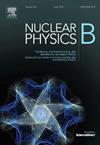Constraining scalars of 16H through proton decays in non-renormalisable SO(10) models
IF 2.8
3区 物理与天体物理
Q2 PHYSICS, PARTICLES & FIELDS
引用次数: 0
Abstract
Non-renormalisable versions of based on irreducible representations with lesser degrees of freedom, are free of running into the catastrophe of non-perturbativity of standard model gauge couplings in contrast to the renormalisable versions having tensors with many degrees of freedom. is the smallest representation, participates in Yukawa Lagrangian at the non-renormalisable level, contributing to the charged and neutral fermion masses, and has six distinct scalars with different charges. We computed the leptoquark and diquark couplings of different pairs of scalars stemming from all possible decomposition of the term resulting from the coupling of with the 16 dimensional fermion multiplet of , i.e. . Computing the tree and loop level contribution of different pairs to the effective dimension six, conserving operators, it turns out only three pairs, viz , and , and can induce proton decay at tree level. Assuming that the Yukawa couplings of the are comparable to those of the of a realistic model and setting the cutoff scale to the Planck scale typically constrains the breaking scale to be orders of magnitude less than the cutoff scale (Λ). Moreover, analysing the branching pattern of the leading two-body decay modes of the proton, we observed a preference for the proton to decay into second-generation mesons due to the hierarchical nature of Yukawa couplings. In a realistic scenario, we find that TeV, while could be as light as a few TeVs.
在不可重整的SO(10)模型中质子衰变的16H约束标量
基于较小自由度的不可约表示的SO(10)的不可重整版本,与具有多个自由度张量的可重整版本相比,不会遇到标准模型规范耦合的非摄动的灾难。16H是最小的表示,在不可重整的水平上参与汤川拉格朗日量,对带电费米子质量和中性费米子质量有贡献,并且具有6个不同的B−L电荷标量。我们计算了不同标量对的轻夸克和重夸克耦合,这些耦合源于16H与SO(10)的16维费米子倍数(即161616H16HΛ)耦合所产生的所有可能的项分解。计算不同对有效维数的树级和环级贡献,得到只有三对,即σ(1,1,0)−T(3,1,13)和H(1,2,−12)−Δ(3,2,16)和H−T可以在树级诱导质子衰变。假设16H的汤川耦合与现实SO(10)模型的126 H的耦合相当,并将截止尺度设置为普朗克尺度,通常会约束B−L断裂尺度比截止尺度小4 ~ 5个数量级(Λ)。此外,通过分析质子主要两体衰变模式的分支模式,我们观察到由于汤川耦合的层次性,质子更倾向于衰变为第二代介子。在一个现实的SO(10)场景中,我们发现MT>;108 TeV,而MΔ可能只有几个TeV那么轻。
本文章由计算机程序翻译,如有差异,请以英文原文为准。
求助全文
约1分钟内获得全文
求助全文
来源期刊

Nuclear Physics B
物理-物理:粒子与场物理
CiteScore
5.50
自引率
7.10%
发文量
302
审稿时长
1 months
期刊介绍:
Nuclear Physics B focuses on the domain of high energy physics, quantum field theory, statistical systems, and mathematical physics, and includes four main sections: high energy physics - phenomenology, high energy physics - theory, high energy physics - experiment, and quantum field theory, statistical systems, and mathematical physics. The emphasis is on original research papers (Frontiers Articles or Full Length Articles), but Review Articles are also welcome.
 求助内容:
求助内容: 应助结果提醒方式:
应助结果提醒方式:


